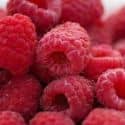Top 10 Fruits Lowest in Sugar

Fruits are high in vitamins, minerals, fiber, water, and probably several other great nutrients yet unknown to nutrition. For people wanting all those great benefits while minimizing their sugar intake, below is a list of the top 10 fruits lowest in sugar.
Low sugar fruits include olives, avocados, starfruit, cranberries, raspberries, blackberries, strawberries, currants, Asian pears, and casaba melon. The list below gives the grams of sugar per serving, and the number of teaspoons of sugar per serving. 1 tsp is equal to 4 grams of sugar.
For more information see the nutrient ranking of low sugar fruits.
List of Low Sugar Fruits
 1 Olives
1 Olives| Sugar in One Large Olive | Sugar per 100g |
|---|---|
| 0g (0 tsp) | 0g (0 tsp) |
 2 Avocados
2 Avocados| Sugar per Avocado | Sugar per 100g |
|---|---|
| 1.3g (0.3 tsp) | 0.7g (0.2 tsp) |
 3 Starfruit (Carambola)
3 Starfruit (Carambola)| Sugar per Cup | Sugar per 100g |
|---|---|
| 4.3g (1.1 tsp) | 4g (1 tsp) |
 4 Cranberries
4 Cranberries| Sugar per Cup | Sugar per 100g |
|---|---|
| 4.7g (1.2 tsp) | 4.3g (1.1 tsp) |
Warning: Cranberry juice and other cranberry products often have a lot of added sugar.
 5 Raspberries
5 Raspberries| Sugar per Cup | Sugar per 100g |
|---|---|
| 5.4g (1.4 tsp) | 4.4g (1.1 tsp) |
 6 Blackberries
6 Blackberries| Sugar per Cup | Sugar per 100g |
|---|---|
| 7g (1.8 tsp) | 4.9g (1.2 tsp) |
 7 Strawberries
7 Strawberries| Sugar per Cup | Sugar per 100g |
|---|---|
| 8.1g (2 tsp) | 4.9g (1.2 tsp) |
 8 Red and White Currants
8 Red and White Currants| Sugar per Cup | Sugar per 100g |
|---|---|
| 8.3g (2.1 tsp) | 7.4g (1.8 tsp) |
 9 Asian Pear
9 Asian Pear| Sugar per Fruit | Sugar per 100g |
|---|---|
| 8.6g (2.2 tsp) | 7.1g (1.8 tsp) |
 10 Casaba Melon
10 Casaba Melon| Sugar per Cup | Sugar per 100g |
|---|---|
| 9.7g (2.4 tsp) | 5.7g (1.4 tsp) |
About the Data
Data for the curated food lists comes from the USDA Food Data Central Repository.
You can check our data against the USDA by clicking the (Source) link at the bottom of each food listing.
Note: When checking data please be sure the serving sizes are the same. In the rare case you find any difference, please contact us and we will fix it right away.
From the Nutrient Ranking Tool
Use the ranking tool links below to select foods and create your own food list to share or print.
- Foods High in Sugar
- Foods Low in Sugar
- Vegetables High in Sugar
- Fruits High in Sugar
- Vegetarian Foods High in Sugar
- Nuts High in Sugar
- Beans High in Sugar
- Dairy High in Sugar
- Breakfast Cereals High in Sugar
- Fast Foods High in Sugar
View more nutrients with the nutrient ranking tool, or see ratios with the nutrient ratio tool.
Related
Data Sources and References
Try the recipe nutrition calculator, or daily meal planner.
Create a free account to log and track foods.
